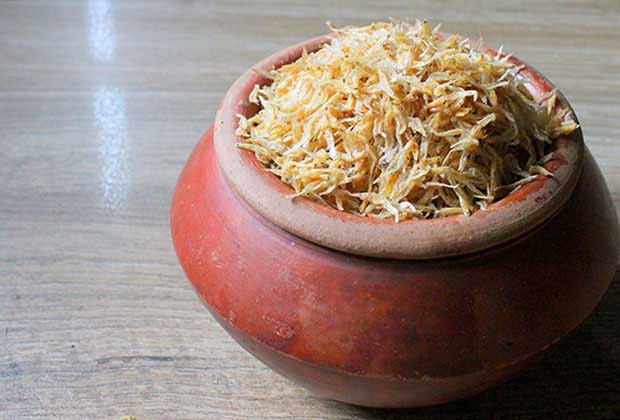A Peek Into The Koli Monsoon Kitchen
- By Anjali KoliLoading...
- | 10 Aug 2016 1:00 PM IST
 X
X
 Kolim sukat or dried shrimps. Photo: Anjali Koli
Kolim sukat or dried shrimps. Photo: Anjali Koli
Men sitting on the verandah, one end of the fishing net tied to the pillar and the free ends being mended, women cleaning dried fish for the day's curry is a common scene in Thal during AagoT or monsoon. Life is slow and gloomy. Everything smells damp, the walls, clothes and even the fishing nets with their saltiness of the sea still intact. A Koli home in Thal has that omnipresent smell of dried fish, which has been stored for the AagoT.
The Koli know that their livelihood depends on the sea and the life within. They follow the tribal laws "take as much as you need but respect the environment". Allow it to rejuvenate periodically. The monsoons mean rough weather and a risk to be at sea. So, it is the ideal time to let the sea creatures breed and replenish life beneath. Legend says that in the monsoons Agasti Muni is furious, and so he bellows in the form of wild wind and enormous waves in the sea. So it makes sense to stop fishing for a few months though officially fishing is closed for shorter time now in the modern day on the West coast of India.
Since fishing is closed, Kolis follow the tradition of stocking up their food and other requirements for the AagoT. What has been earned in the rest of the year is carefully budgeted and saved for the monsoon. Dried beans and pulses are stocked in the pantry. Fish, plain and salted, is dried in the summer months. Typically the fish that are dried are prawns in three sizes, large are deshelled and dried. The medium and tiny ones are dried as whole. Each tastes different. The other types of fish that are loved dried are Bombil or Bombay duck, Vakti or ribbon fish and khare or anchovies.
 Vakti or ribbon fish. Photo: Anjali Koli
Vakti or ribbon fish. Photo: Anjali Koli
Read how to store and handle dried fish here.
When the boats are on the shore, and the community needs their dose of fresh seafood the women and men go foraging rock oysters or kalva, seasnails or khubya and the mud fish or nivate. They make delicious curries. Crabs and lobsters are also caught nearer to the shore and are the tastiest at this time.
Most Kolis turn vegetarian during Shravan though the period of Chaturmaas or four months this year from July to November is considered holy. You bet a Koli cannot survive without non-vegetarian so it's not followed in the community.
Several of the dried fish are paired with veggies to tone down the smell and make the fish palatable. Sharing here one such recipe, which uses the stocked up dried prawns or sode and bottle gourd that grows wild over the tiled roofs of village homes in this season.
 Sode or dried prawns. Photo: Anjali Koli
Sode or dried prawns. Photo: Anjali Koli
Recipe for Sode Dudhi
Ingredients
1 bottle gourd about 500- 600 gms, peeled and cubed
1/2 cup dried sode or dried prawns
1/4 cup grated fresh coconut
1 teaspoon cumin seed
2-3 green chilies
1/2 teaspoon garam masala
1/2 teaspoon Koli masala
1/4 teaspoon turmeric
handful of cilantro
1 tablespoon oil
Salt to taste
Method
1. First soak the dried prawns in warm water for at least 30 mins.
2. Then grind together grated coconut, green chilies, cumin seeds, turmeric, cilantro and Koli masala into a paste with minimum water.
3. Heat oil in a pot. Add the peeled and cubed bottle gourd into the hot oil. Now let in the rehydrated prawns or sode. Discard the water. Cook till the sode are cooked through and crumble when pressed between the finger. Tip in the ground masala. Add salt to taste and a cup of water. Sprinkle the garam masala and cook till fragrant. The Sode Dudhi should have a gravy just enough to scoop up.
4. This goes best with crisp rice roti, but try it with rice if you care for it or a roti of your choice.



